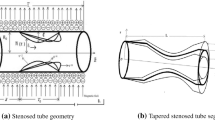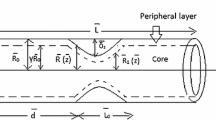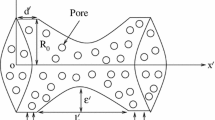Summary
A two-phase magnetic fluid model for pulsatile flow of blood has been investigated by using realistic input data (pressure gradient). Closed form analytic solutions have been obtained. It is observed that the existing analysis could be improved by including driving force profiles (this could help in detecting the numerical, algebraic or formulation error to some extent) and two types of velocity profiles. Further, a new nondimensional numberS N is introduced which can be used to control the flow and its behavior. It is possible to make the flow stable or unstable with a proper choice ofS N. This could be exploited for many interesting applications, e.g. in bloodless surgery, in designing magnetic band aids for first aid box (for snake bites and to stop the blood loss from injuries in accidents and wars).
Similar content being viewed by others
References
Womersley, J. R.: Method for the calculation of velocity, rate of flow and viscous drag in arteries when the pressure gradient is known. J. Physiol.127, 533–563 (1955).
Lightfoot, E. N.: Transport phenomenon in living systems. New York: Wiley 1974.
Sud, V. K., Sekhon, G. S.: Arterial flow under periodic body acceleration. Bull. Math. Biol.47, 35–52 (1985).
Chaturani, P., Palanisamy, V.: Pulsatile flow of blood with periodic body acceleration. Int. J. Engng Sci.29, 113–119 (1991).
Srivastava, L. M., Srivastava, V. P.: On two-phase model of pulsatile blood flow with entrance effects. Biorheology20, 761–777 (1983).
Srivastava, L. M., Edemeka, U. E., Srivastava, V. P.: Effects of external body accelerations on blood flow. Jpn. J. Appl. Phys.33, 3648–3655 (1994).
Wagh, D. K., Wagh, S. D.: Blood flow considered as magnetic fluid flow. Proc. Physiol. Fluid Dyn.III, 311–315 (1992).
Saffman, P. G.: On the stability of laminar flow of a dusty gas. J. Fluid Mech.13, 120–128 (1962).
Nayfeh, A. H.: Oscillatory two-phase flow through a rigid pipe. AIAA J.4, 1868–1871 (1966).
Chaturani, P., Saxena-Bharatiya, S.: Improved input data for mathematical model of pulsatile flow of blood. Proc. 24th Nat. Conf. of FMFP G-27-33 (1997).
Rosensweig, R. E.: Ferrohydrodynamics. New York: Cambridge University Press 1985.
Milnor, W. R.: Hemodynamics. Baltimore: Williams and Wilkins 1989.
Author information
Authors and Affiliations
Rights and permissions
About this article
Cite this article
Chaturani, P., Bharatiya, S.S. Magnetic fluid model for two-phase pulsatile flow of blood. Acta Mechanica 149, 97–114 (2001). https://doi.org/10.1007/BF01261666
Received:
Issue Date:
DOI: https://doi.org/10.1007/BF01261666




